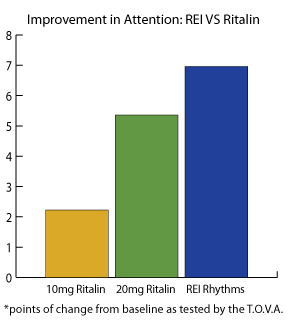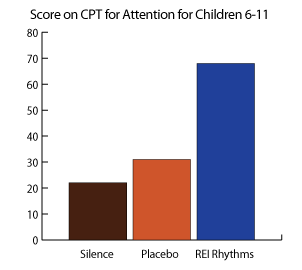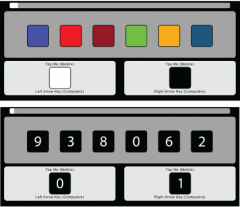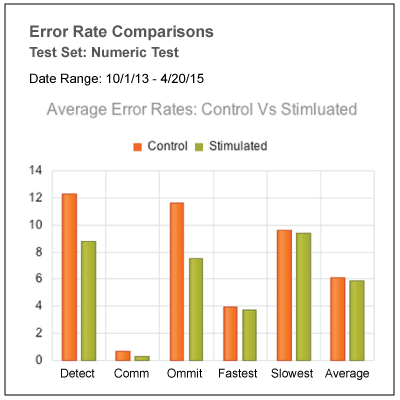The following is an excerpt from my book, Different Drummer, exploring how the REI Custom Program can improve sensory processing.
Learn more about the REI Custom Program
Sensory processing issues are common among the people I work with. In fact, sensory challenges are part of nearly everyone who falls into the developmental disability spectrum, including people with ADHD and autism. Sensory processing issues come in three basic forms: sensory-defensive, sensory-seeking, and poor sensory discrimination.
Sensory defensiveness is characterized by being easily overstimulated by sensory input. This is the child who recoils to touch, won’t wear shoes, covers his ears in response to loud noises, gets dizzy easily, or throws up in the car.
Easily overstimulated people constitute most of my clients with sensory issues. I work to reduce their sensitivity to stimulation by giving their brains more stimulation.
“What do you mean by stimulation?” Laurel asked. “Emily is always overstimulated. Why would you add more, and how could it calm her down?” This was one of the first questions she asked me after I began to work with her daughter, Emily.
From her very first track, Emily responded immediately and decisively to the drumming. After just one listening, her emotional outbursts increased and her sleep, already poor before the Program, deteriorated further. Upon her first night on the REI Custom Program, she needed to be held by her mother to calm down.
Laurel and I quickly discovered that Emily needed less stimulation, far less than a Program usually begins with. In fact, I had to step down the level of stimulation on her tracks to a point lower than what was on our ‘stimulation low enough for anyone’ Calming Rhythms CD. Once we determined a stimulation level she could tolerate, we were then able to slowly begin adding more stimulation and progressively build her tolerance to address her sensory issues.
“Stimulation is related to the complexity of the rhythms on the track,” I described to Laurel. “I have built a series of rhythmic structures, varying in their length and complexity, for each symptom.
“By complexity, I mean the difficulty needed to decipher the rhythm’s pattern. Think of the brain as a computer whose central job, when dealing with a sensory stimulus, is to decipher and categorize the stimulation.
“Emily takes in sensory stimulus at a very high level. It’s as if her volume control is turned way up. Everything comes at her with an intensity that is higher than for you or me. And she can’t turn down the volume. A light touch may feel like a hard squeeze, or a normal voice level may sound like a shout. Our goal with the REI tracks is to teach her sensory system to turn the volume down and to learn to distinguish important from unimportant sensory input.
“With each track, we want to increase the level of stimulation we can give her so that she becomes used to it. Over time, she’ll develop the skills to be able to moderate the stimulation she receives.”
Before I made her first Program track, Emily, who was four at the time, wouldn’t wear clothes, preferring to only wear undies. Some- times she would wear shorts or a skirt but she was never okay with a shirt. And don’t even think about a coat. She also slept poorly, often waking at night or early in the morning, unable to get back to sleep. Emily was also anxious, and Laurel needed to be with her at all times lest she has a meltdown.
Laurel was one of my favorite parents. She was engaged and inquisitive. And the two years I spent working with her extremely sensitive daughter was one of the most satisfying—and sometimes perplexing—experiences of my career.
Emily mirrored many challenges exhibited by a six-year-old boy I worked with a few years before. Gerald had both tactile and auditory sensitivities. He wouldn’t wear shoes or socks and would cover his ears, or sometimes cry or scream, when someone turned on music, even if the volume was low.
He also tended to isolate himself from his family, preferring to be in his room alone, playing with toys by himself. If a sibling or cousin came in his room, he’d have a meltdown.
For Gerald, the Program was pretty straightforward. He responded within the first two weeks in all areas.
“Gerald is doing great with the Program,” said Jenna, his REI provider. Jenna, an occupational therapist in south Texas, was our first active provider and this was one of her first clients. We were both excited by Gerald’s progress, especially by his quick response to REI.
“He’s been wearing socks and shoes every day, since the end of the first week. Yesterday he joined his extended family outside and played with his brothers and cousins. He now lets his mom turn music on in the car and he has also been rocking out to his own pop music in the house.”
“That’s pretty quick progress. Is he using CD #2 yet?”
“He just started the other day. So far the transition is going well.” The transition from CD #1 to CD #2, at this time in the history of the REI Custom Program, was sometimes difficult because of the jump in stimulation.
The first CD (and first track with the current Program) generally focuses on reducing anxiety and sets the foundation for improving sleep issues, if there are any. The subsequent tracks progressively build stimulation and broaden their focus to include other areas of concern.
When sensory sensitivities reduce during the first track, it usually means that they are related to anxiety. This was my assumption with Gerald.
I had no such assumption with Emily when she started the Program. This is because, even though she had a similar symptom make- up, she also had sleep issues and a more heightened response to overstimulating environments.
“We’ll start with trying to help Emily’s sleep,” I said to Laurel when we started the Program. “If she can fall asleep more easily and not wake up, we may also see some improvement in her sensitivities. Sometimes being tired, especially chronically, can increase the presence of these symptoms. Her overreaction to things, in general, suggests that this may be the case.”
“So, do I play the track at bedtime, then? Can I play it all night long to help her stay asleep or turn it on again if she wakes up?” asked Laurel.
“Yes, turn it on at bedtime. Just play it once through. If she wakes up, it’s okay to turn it on again, but only once. With any luck, she’ll be able to stay asleep after a couple of weeks of this pattern.”
Many of our clients wake up at night. In fact, falling asleep is often not a problem. It’s the night waking. And this is probably one of the most difficult things for a parent to deal with. Having your night interrupted, night after night, becomes wearing and leads to a host of problems.
The kids who wake up at night often wake up ready to go for the day. Getting them back to sleep can be exhausting. So, the first and most important thing for us to focus on is to help the child sleep so the parents can sleep, too.
“Emily slept all night the fifth night,” Laurel told me at her two-week check-in. “She slept through the night for the next week and started waking up again the last couple of nights. Do you think we need to change tracks?”
“It sounds like it.” I made a new track and waited to hear from Laurel again in another two weeks.
“Emily slept through the night again when we started the new track, but she started waking up again the last couple of days.”
And so a pattern started to emerge for Emily. Sleep was a barometer to how a given track was working for her. Every time I made a new track, Emily would sleep well for a while and then she’d start waking up again.
“How are her anxiety and sensory issues?” I asked after the third track, hoping that we’d now start seeing some changes there.
“Oh, I forgot to mention this because I’ve been so focused on her sleep, but she’s now letting me put on a shirt,” Laurel added, sounding like it’s not a big deal.
“Wow, that’s great! When you started, she’d melt down if you tried that,” I added, trying to help her see what a big change this was. When we first talked, Laurel was much more concerned with Emily’s tactile sensitivities than she was by her sleep, but our focus on the sleep issue seemed to make her not as aware of Emily’s tactile improvements.
“Yeah, I guess it is a big change. And come to think of it, she hasn’t been melting down as much,” she said as we talked about where Emily was before the Program started.
This isn’t uncommon. Many times people are so focused on playing the track and dealing with whatever is up that it’s hard for them to see the big picture unless it’s pointed out to them.
This is one of the most helpful things about our REI providers. Since they can’t make the CDs or even mix-and-match pre-recorded CDs as is common in other auditory programs, many providers feel like they don’t have an important role in REI. The key to their role is their relationship with their clients: It is valuable not only to help me see what the real issues are but also to help the client gain perspective on how much progress they’ve made.
Laurel didn’t always need to be reminded of where Emily started. She became keenly aware. In fact, she was one of the most astute observers of her daughter’s progress with the REI Program.
“Emily has been weepy the last few days in this track,” Laurel told me a few more weeks into her Program. “She did fine for the first week then she started crying for no reason. It’s not like a meltdown. She’s not reacting to anything going on around her. She’ll just stop and cry. Could it be the track?”
“I don’t know. It could be, I suppose. How is she sleeping? How are her sensitivities?”
“She’s sleeping okay. She has been a little fussy about clothes. She’ll only wear one particular shirt and she doesn’t want to wear shoes anymore. Do you think we should try a new track?”
“That’s what I’m thinking. I’d guess that this track is probably too stimulating for her.”
I made a new track. Laurel called a week later.
“She’s not weepy anymore and she wearing shoes again. What did you do with the new track?”
“I went back to rhythms we used in Track #2 and rearranged them. I looked at your current track (#3) and noticed that it had changed databases and drums. The Udu drum is much more stimulating than the Gonga, and I’m guessing that had an impact on her.”
“I noticed it sounded like a different drum. Why would that matter?”
“The Gonga drum has a pretty soft, rounded tone. The Udu is really sharp. As well, on the Gonga I tend to use rhythms that are less complex and carry a longer structural flow than those played on the Udu. The Udu tracks tend to be much more stimulating than the Gonga tracks because the drum’s sound is more pointed and the rhythms more complex. Someone as sensitive as Emily may find the Udu uncomfortable to listen to.”
An REI Custom Program will draw from eight databases and switch back and forth between the Gonga and Udu. Even though the Udu drum rhythms tend to be more stimulating, the stimulation is presented on a scale. So a particular database of Gonga rhythms may be more stimulating than another database of Udu rhythms. In fact, each database used for the Custom Programs are progressively more stimulating;, so even though database two is an Udu, the rhythms are less stimulating than the rhythms played on the Gonga in database three.
We discovered that Emily was never able to handle the Udu tracks. I had to alter her Program so that we never drew from the Udu databases. She could handle fairly high-intensity Gonga rhythms, but not lesser stimulating Udu drums. Fortunately, I was able to accommodate her.
Over the course of almost two years, Emily made significant progress in her anxieties and sensory issues. Then Laurel offered me another opportunity.
“Are you ready to work with my other daughter?” she asked. “Lila is the polar opposite of Emily. She is a sensory sponge. She could spend all day in the swing.”
“Okay, let’s give it try.”
Like Emily, Lila was four-years-old when I started working with her. Unlike Emily, who withdrew from sensory stimulus, Lila was a classic sensory seeker. She was high energy, high activity.
Her response to her Program was also harder to track than Emily’s. For instance, Emily’s sleep would change when she was ready for a new track. She also made steady progress, as long as we changed tracks on her schedule.
Lila, on the other hand, could stick with the same track forever without showing any negative effects. With Lila, we needed to be more vigilant in changing her tracks on time in order to move her forward. She soaked up all the stimulation her Program would offer.
In some ways, a client like Lila is easy because I never have to contend with, or even worry about, overstimulation. Overstimulation generally causes sleeplessness, anxiety, and agitation. Once we see overstimulation in a client, we tread pretty carefully from that point forward to ensure that she doesn’t become overstimulated again.
Someone like Lila, though, doesn’t react as strongly. Because she can handle so much stimulation, it takes more intense rhythms and more frequent changes to the tracks to ensure that she makes progress. If I’m not seeing tangible progress by Track #3, then I step up the stimulation further. If progress doesn’t happen even after adding more stimulating REI tracks, I’ll sometimes also ask that the REI tracks be played more than once a day.
Lila didn’t need these contingencies. Her sensory-seeking became less pronounced during her second track, about three weeks into her Program. She was sleeping better and was less anxious overall. Other than that, Lila was hard to read. She didn’t react strongly to a track as Emily did. She showed a slow, steady pace. Laurel was used to reacting to Emily’s response to a track and felt a little lost when it came to knowing how Lila was responding.
“Lila is different than Emily in many ways, but the curious thing about the REI is that she just goes with the flow.”
“Sensory seekers tend to be more consistent than sensory defensive people,” I described. “I think that someone who is seeking sensory input tends to run at a pace that keeps them stimulated. They may not react to sensory input as much because they are still seeking more.
“A sensory defensive person, on the other hand, has a threshold that may change depending on how they feel. Different types of stimulus have different effects on them. So, unless they experience the same type and level of stimulation, you’re going to see some variability in their response to stimulus and, in turn, in their behavior.”
“That makes sense. I really see that with Emily. There are days when she can handle going to the grocery store, but there are other days when she melts down. Same thing with school. That’s the most difficult thing about Emily’s sensory issues: I can’t predict how she is going to respond to something. Just when I think she’ll be okay with going somewhere, she’ll have a meltdown.
“Lila, on the other hand, is always busy. This consistency, although it’s hard, is easier to handle because I can plan for how she’ll react to something.”
Though I see quite a few people who are sensory-seeking like Lila, more clients are on the sensory defensive side, like Emily. Either way, because I can fine-tune the stimulation for each person, I can accommodate their sensory needs and hopefully help them learn to more efficiently process sensory input.
Learn more about the REI Custom Program
Listen to personalized music for your brain at https://brainstimaudio.com








